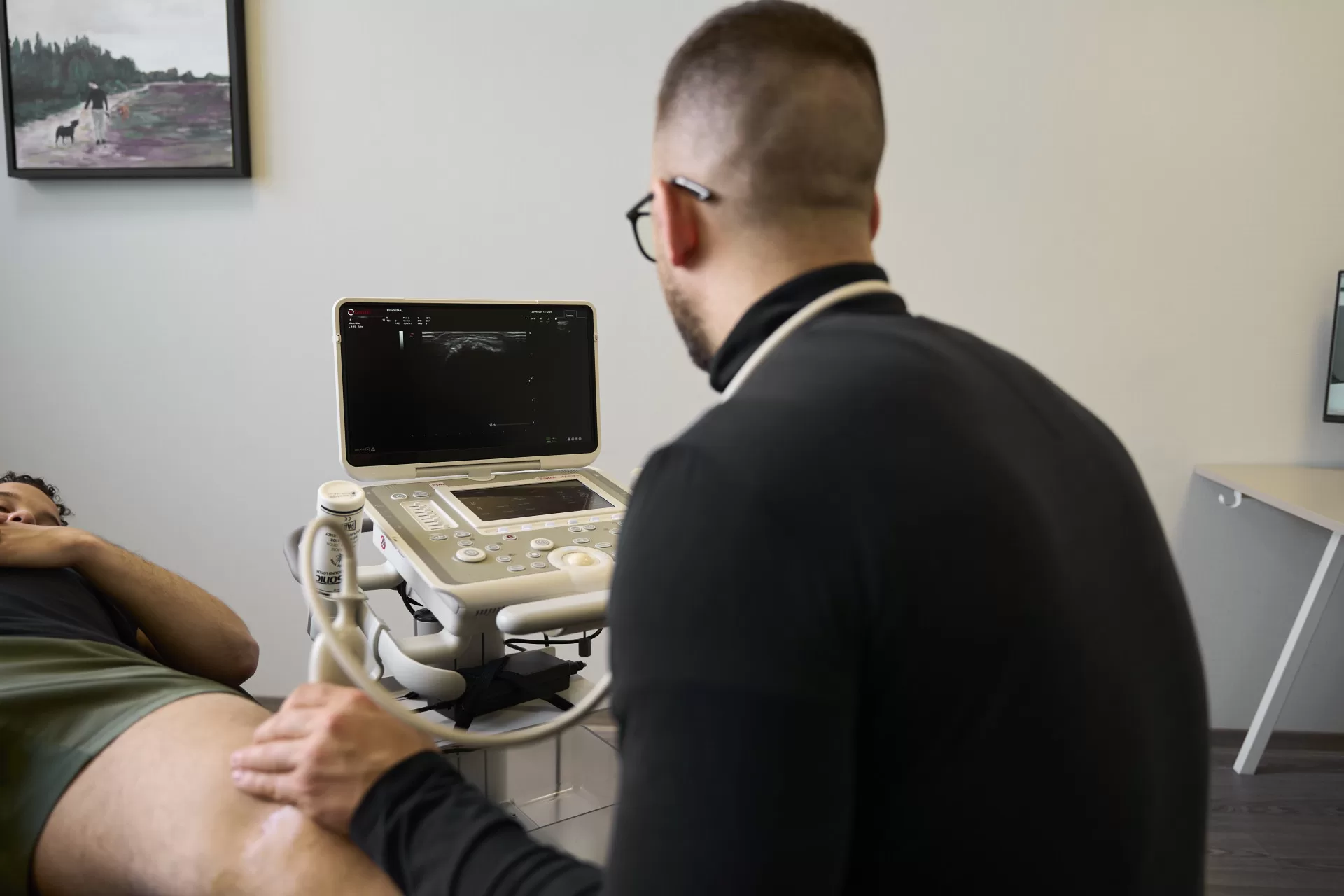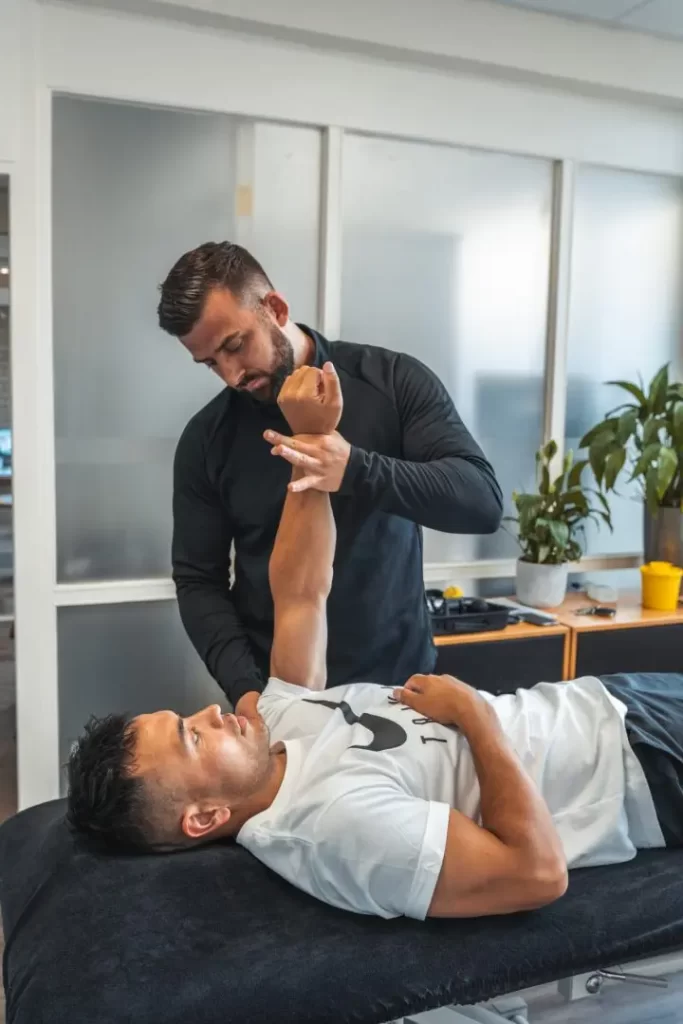Ultrasound diagnosis and examination

What is ultrasound
Ultrasound uses high-frequency sound waves to produce detailed images of muscles, tendons and other connective tissue structures in the body. This is done through the transducer, which emits sound waves that bounce through the body and produce images when they encounter structures such as tendons and muscles.
These echoes are captured by the transducer and converted into images by a computer. These images are then displayed on a screen, allowing therapists and doctors to directly analyse and interpret the images.
This technique allows early recognition of irregularities and damage to tissues, such as small tears in tendons or inflammatory processes in muscles. This gives the sports physiotherapist immediate insight into the specific biomechanics and limitations associated with the complaints. This detailed insight is crucial for determining recovery options and tailoring treatment to the athlete's specific requirements.
Benefits of ultrasound examination Physiotherapy
Ultrasound offers many benefits that make it a valuable addition to physiotherapy. Especially for the diagnosis and treatment of disorders of muscles, tendons and other connective tissues. Here are some of the main benefits:
Fast Diagnosis and Access Times: Ultrasound allows physiotherapists to quickly and efficiently get a clear picture of the body's internal structure. This means patients can be diagnosed quickly, often during their first visit, significantly reducing access times to treatment.
Lower costs: Compared to other imaging techniques such as MRIs or CT scans, ultrasound is a cost-effective option. This makes it an accessible choice for many people, without compromising on the quality of diagnosis.
No Radiation: Unlike X-rays or CT scans, ultrasound does not use ionising radiation. This makes it a safer option, especially for repeated use, which is important for complaints that require regular evaluation.
Quick diagnosis: By providing immediate insight into the state of the tissue, physiotherapists can give accurate and targeted advice. This increases the effectiveness of treatment and reduces the risk of further damage from incorrect treatment methods.
Right Treatment Plan: With the detailed information provided by ultrasound, physiotherapists can immediately create an appropriate treatment plan. This plan is specifically tailored to the unique needs of the injured region, leading to faster results.
These benefits make ultrasound an essential part of modern physiotherapy care, allowing patients to be treated faster and more effectively.
While ultrasound offers many advantages in physiotherapy, there are also some drawbacks and limitations to this technique. It is important to recognise these to get a full picture of what ultrasound can and cannot offer:
Limited Imaging: Ultrasound is very effective for assessing tissues such as muscles, tendons and ligaments. But it has limitations when mapping structures inside joints. This is because sound waves find it difficult or impossible to penetrate deeper structures such as joint capsules and bone tissue.
Operator-dependent: The quality of ultrasound images and the accuracy of interpretation are highly dependent on the skill and experience of the operator. This means that diagnostic accuracy may vary between different therapists.
During an ultrasound consultation at Physio Fitaal, you can expect the following
Preparation: You will be asked to wear clothes that allow easy access to the area to be examined or you may be asked to partially undress. Make sure the area is free of lotions or creams.
The Echo device: An ultrasound uses a small hand-held device called a transducer, which emits sound waves. These waves bounce back from the tissues in your body and are picked up again by the same device.
Use of Gel: A special gel is applied to your skin on the area to be examined. This gel helps guide the sound waves and ensures clear imaging.
Scan: The physiotherapist moves the transducer over the area to obtain different images. You may be asked to move in certain positions to get the best images.
Review of Images: The images are displayed on a monitor, allowing the physiotherapist to assess them. The therapist will analyse the images to identify any abnormalities or conditions.
Discussion and Plan: After scanning, the physiotherapist will discuss the findings with you and explain what the images show. Depending on the results, a treatment plan is drawn up or recommendations are made for further tests or treatments.
Follow-up: If necessary, a follow-up appointment can be scheduled to review progress or carry out further evaluations.
An ultrasound consultation is a non-invasive and painless procedure that provides information for accurate diagnosis and effective treatment. It allows you and your therapist to get a clear picture of your body's internal structures, which is essential for targeted treatment.
Reimbursement for ultrasound
The following rates apply for ultrasound consultations at Physio Fitaal:
First ultrasound consultation diagnostics: €60,-
Follow-up ultrasound consultation: €40,-
During the first ultrasound consultation, a comprehensive intake takes place where we go over your specific complaints and medical history, followed by the ultrasound itself. This consultation is essential for establishing an accurate diagnosis and creating an effective treatment plan. Follow-up ultrasound consultations are designed to monitor progress and adjust the treatment plan if necessary.
When you undergo an ultrasound consultation at Physio Fitaal, it falls under Physiotherapy in terms of reimbursement by your health insurer. Below are important points about reimbursement:
Additional Insurance: To be eligible for reimbursement, you must have supplementary health insurance that covers physiotherapy.
Contracts with Insurers: Fysio Fitaal has contracts with most health insurers. However, it is advisable to check prior to your appointment whether your specific health insurer has a contract with our practice, so you can be sure that the costs will be covered.
Direct Accessibility: Physiotherapy, including ultrasound consultations, is directly accessible. This means you can visit without a referral.
Information and Support: If you have questions about reimbursement or are not sure how your insurance covers the cost, our administrative staff can help and advise you.
It is always wise to contact your health insurer before your treatment to avoid surprises and make sure you are eligible for reimbursement.
For which complaints are suitable

Trochanteric major pain syndrome
The trochanter major is a protruding piece of bone on the outside of the thigh

Medial band knee(MCL)
An injury to the inner ligament of the knee requires accurate diagnosis and a...

Traumatic osteoarthritis after a knee injury
Post traumatic osteoarthritis is a subtype of osteoarthritis and occurs after a significant injury

Iliotibial band syndrome
In most cases, irritation of the iliotibial band causes pain on the side...


Injury to the posterolateral complex
In an injury where the forces are great enough, there can be actual damage from...

Patella femoral pain syndrome
Patella femoral pain syndrome is an umbrella term for several complaints at the front of the...

Frequently asked questions
When can ultrasound be used?
Physiotherapists apply ultrasound for complaints such as muscle and tendon injuries, inflammation, bursitis and other soft tissue pathologies. It allows them to accurately assess the nature and severity of the injury and draw up an appropriate treatment plan.
How long will the examination take?
During the examination, the physiotherapist applies a special gel to the skin and moves a transducer over the area to be examined. This process is painless and usually takes between 5 and 10 minutes, depending on the complexity of the complaint.
Is ultrasound safe?
Yes, ultrasound is a safe and non-invasive method with no known risks or side effects. It does not use radiation, such as X-rays, and can therefore be applied repeatedly if needed.
Is ultrasound reimbursed?
In many cases, ultrasound is reimbursed within physiotherapy from the supplementary insurance. It is advisable to consult your policy conditions or contact your health insurer for specific information on reimbursements.
Do I need a referral for an ultrasound?
In most cases, you can visit a physiotherapist for an ultrasound examination without a doctor's referral. However, it is wise to check with the relevant practice or your health insurer beforehand.
What clothes appropriate for ultrasound examination?
In general, no special preparation is required for an ultrasound examination. It is recommended to wear comfortable clothing so that the area to be examined is easily accessible.
Making an appointment at FysioFitaal
We work from multiple locations in Tilburg, always close by for professional and accessible physiotherapy. Fill in the contact form and we will contact you soon. Together, we will work on your recovery!

